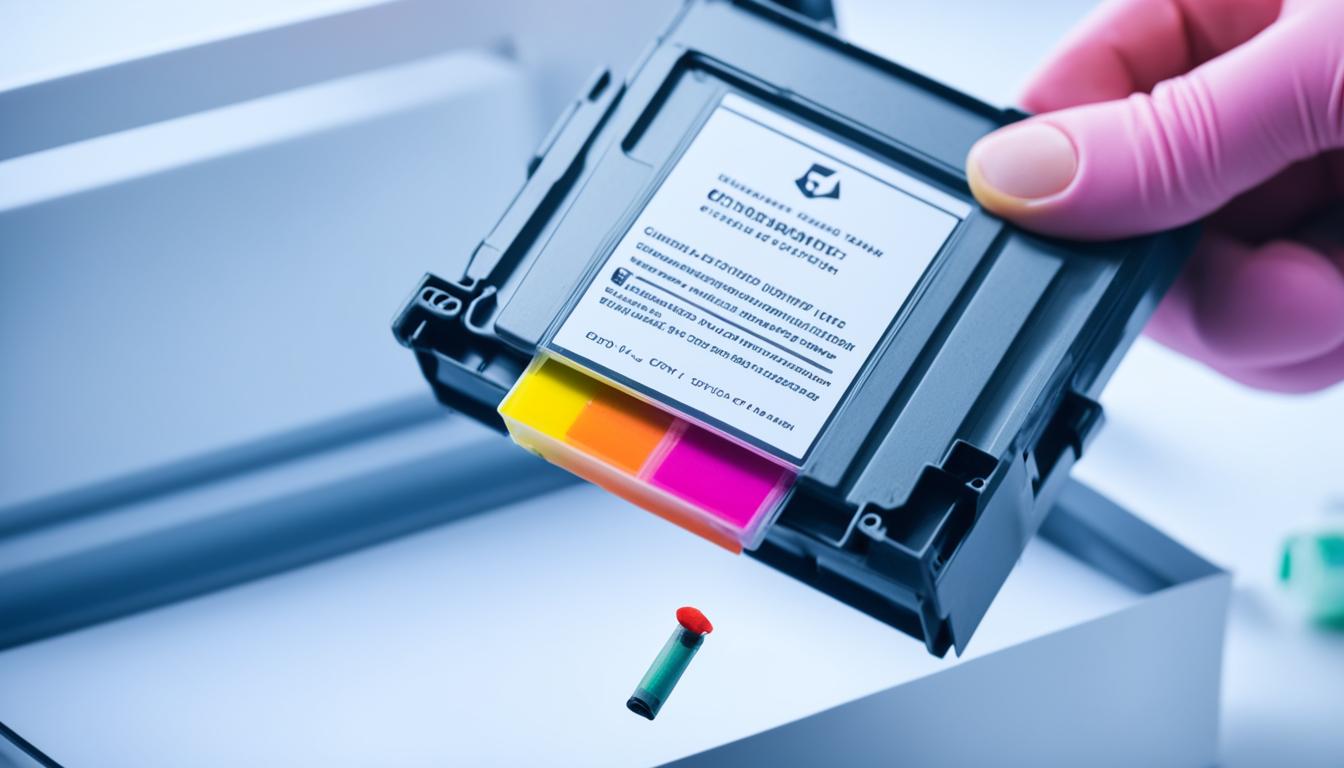Printer ink is a common household item used for printing documents and photos. Many people wonder if printer ink is toxic and what safety precautions they should take when handling it. In this article, we will explore the ingredients of printer ink, potential hazards, and provide safety tips to ensure safe usage.
Printer ink and toner products are generally made with adherence to industry standards and safety guidelines. While most inks and toners are non-toxic, it is important to note that the specific contents can vary by brand and product. Printer ink is composed of water, ethylene glycol, alcohol, dyes, and pigments. Swallowing printer ink can make you sick, although it is not considered highly toxic. However, printer ink can be harmful to pets, especially dogs and cats, as they may be attracted to the sweet taste of ethylene glycol. Laser printers use toner, which contains compounds that can be dangerous in large quantities, such as carbon black, known to cause cancer.
It is crucial to handle ink and toner properly and to use authentic, brand-name products to reduce health concerns. By following safety guidelines and taking necessary precautions, you can ensure a safe printing experience for yourself and those around you.
Key Takeaways:
- Printer ink is generally non-toxic, but its specific contents can vary by brand and product.
- Swallowing printer ink can make you sick, and it can be harmful to pets due to the sweet taste of certain ingredients.
- Laser printer toner contains compounds that can be dangerous in large quantities, including carbon black, known to cause cancer.
- Handle ink and toner properly, and use authentic, brand-name products to reduce health concerns.
- Follow safety guidelines and take necessary precautions to ensure a safe printing experience.
What is Printer Ink Made of and is it Toxic?
Printer ink is composed of several ingredients that work together to produce high-quality prints. The main components of printer ink are water, ethylene glycol, and alcohol. These substances serve as solvents and help to keep the ink in a liquid form that can easily flow through the printer cartridges. They also aid in preventing the ink from drying out.
In addition to the solvents, printer ink also contains dyes and pigments that provide the color. These dyes and pigments vary depending on the desired shade and intensity of the ink. They are responsible for the vibrant hues and accurate color reproduction that we see on printed documents and photos.
It is important to note that while the basic ingredients of printer ink are not inherently toxic, consuming ink can make you sick. Printer ink is not intended for ingestion, and it is crucial to keep it out of reach of children and pets.
On the other hand, laser printers use toner, a fine powder that consists of polymer and carbon powder. Toner is used in the printing process of laser printers and is responsible for creating the image on the page. While toner is not considered toxic under normal circumstances, it can be dangerous if exposed to in large quantities or if inhaled. Carbon black, which is used in black toner, has been classified as a possible carcinogen.
Printer Ink Ingredients:
Here is a breakdown of the ingredients commonly found in printer ink:
| Ingredient | Function |
|---|---|
| Water | Solvent and carrier for other ingredients |
| Ethylene Glycol | Solvent that prevents ink from drying out |
| Alcohol | Solvent that aids in rapid drying of the ink |
| Dyes and Pigments | Provide color and vibrancy |

While printer ink and toner are generally considered safe for their intended uses, it is important to handle them carefully. Avoid direct contact with the skin and eyes, and follow proper safety guidelines when refilling or changing cartridges. Using authentic, brand-name printer ink and toner can help ensure the highest quality prints and minimize potential health risks.
Potential Hazards of Printer Ink and Toner
Printer ink and toner are essential components in printing, but it’s crucial to be aware of the potential hazards they may pose. These products can contain chemicals such as formaldehyde, benzene, and toluene, which can be harmful if ingested or absorbed through the skin.
Exposure to these chemicals can lead to various health issues, including respiratory irritation, dizziness, nausea, and headaches. It’s important to prioritize safety when using printer ink and toner.
Here are some key precautions to take:
- Read labels and follow instructions: Be sure to carefully read and understand the labels on printer ink and toner products. The manufacturer’s instructions should guide you on safe handling and use.
- Protect your skin: When handling ink and toner, it’s essential to wear gloves and avoid direct contact with your skin. This can help minimize the risk of absorption and potential health hazards.
- Proper disposal: Safely dispose of ink and toner cartridges following the recommended guidelines. Improper disposal can harm the environment and pose risks to others.
By following these safety measures, you can mitigate the potential hazards associated with printer ink and toner. Remember, it’s better to be cautious and prioritize safety when working with these substances.
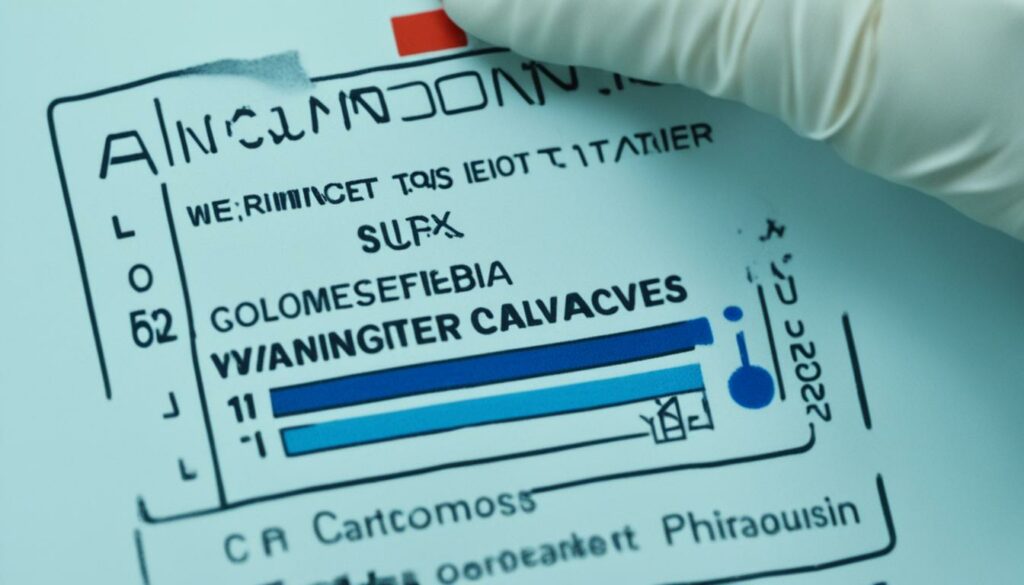
| Hazardous Chemicals | Health Effects |
|---|---|
| Formaldehyde | Respiratory irritation, nausea |
| Benzene | Dizziness, headaches |
| Toluene | Headaches, dizziness |
How to Handle Ink Accidents and Clean Ink Stains
If you have an ink accident and get ink on your skin, it is important to clean it off as soon as possible. Here are some tips to help you handle ink accidents and clean ink stains effectively:
- Wash your hands: If you have light ink stains on your skin, washing your hands with soap and warm water should be sufficient to remove the ink. Make sure to scrub gently and rinse thoroughly.
- Use solvents: For more stubborn ink stains, you can use solvents like rubbing alcohol or vinegar. Apply a small amount to a clean cloth or cotton ball and gently dab the ink stain until it starts to break down.
- Nail polish remover: If you have ink stains on your fingernails, nail polish remover can be effective in removing them. Apply a small amount to a cotton ball and gently rub the stained area until the ink starts to lift.
When it comes to handling ink and toner, prevention is key. Wearing gloves when changing or refilling cartridges can help prevent ink from getting on your skin. It’s also important to follow proper cleaning techniques and use the appropriate materials to remove ink stains effectively.
Remember, swift action is crucial in dealing with ink accidents and stains. By being prepared and knowing how to clean ink effectively, you can minimize the impact of ink mishaps.
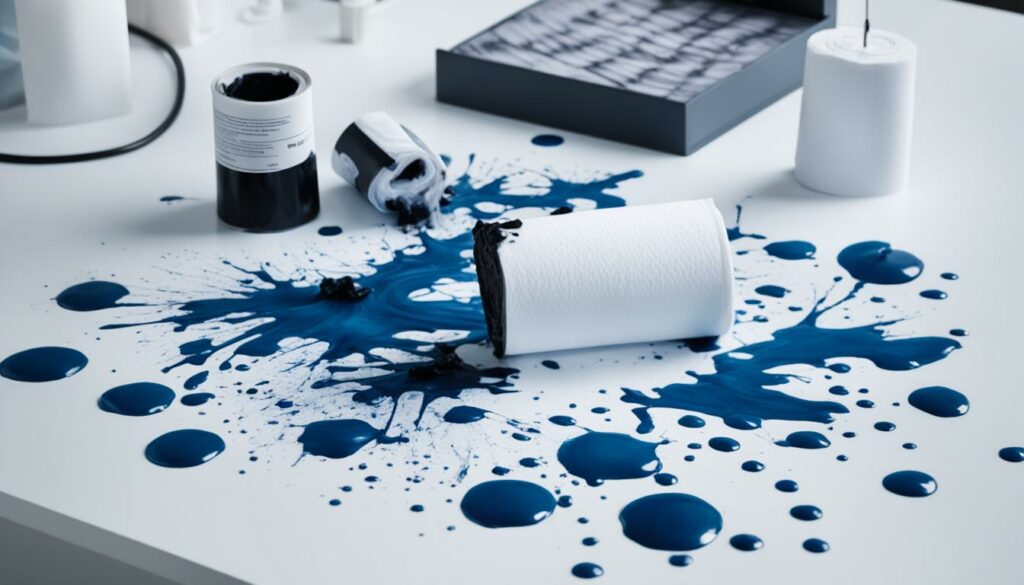
Safety Precautions When Working with Printer Ink and Toner
When handling printer ink and toner, it’s crucial to prioritize safety to protect yourself and minimize potential risks. By following a few safety precautions, you can ensure a safe working environment and prevent any harm that might arise from exposure to printer ink and toner.
Here are some essential safety measures to keep in mind:
- Proper handling: Always handle printer ink and toner cartridges carefully. Avoid shaking them as this can cause leaks. Additionally, make sure to keep them away from food, drinks, and open flames to reduce any potential risks.
- Storage: Store ink and toner cartridges in a cool, dry place, away from direct sunlight or extreme temperatures. This will help preserve their quality and reduce the likelihood of accidents or spills.
- Protective gear: When handling ink cartridges, consider wearing chemical-resistant gloves to minimize skin contact and potential exposure. This simple precaution can significantly reduce health risks.
- Avoid inhalation: For those working with laser printers that use toner, wearing a mask or respirator can provide protection against harmful dust and particles that may be released during the printing process.
- Proper disposal: It’s essential to dispose of used ink and toner cartridges responsibly. Follow local regulations and guidelines for disposing of these items to prevent any harm to the environment. Many manufacturers provide recycling programs for their cartridges, making it easy to dispose of them safely.
- Choose reputable brands: Researching and purchasing ink and toner brands known for their commitment to safety and lower toxicity levels is highly recommended. Opting for authentic, brand-name products can provide peace of mind and reduce potential health concerns.
By adhering to these safety precautions, you can reduce the risks associated with working with printer ink and toner, ensuring a safe and efficient printing experience for yourself and those around you.
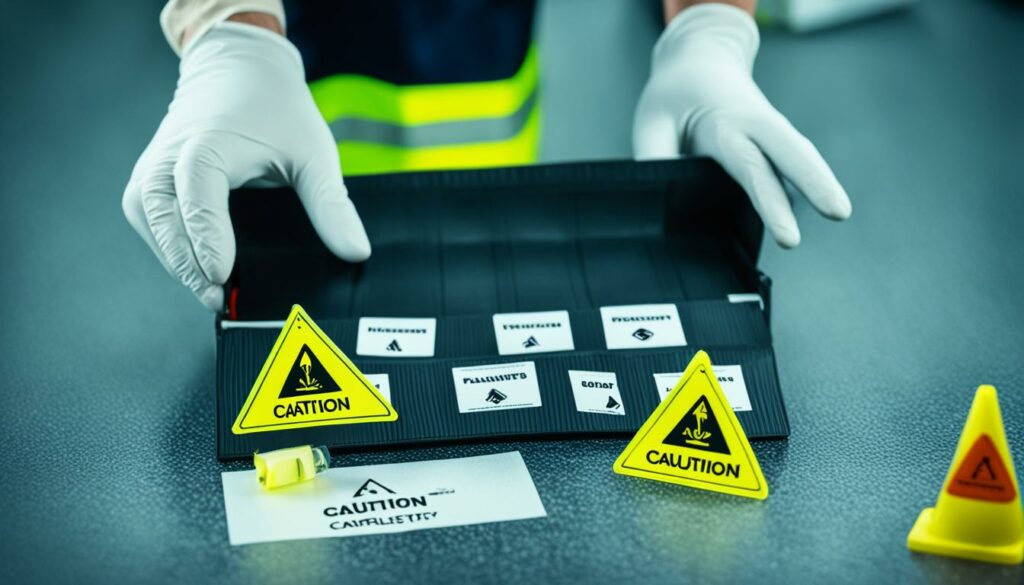
Is Printer Ink Toxic? The Verdict
Printer ink and toner, when used as intended, are generally safe and not highly toxic. Liquid printer ink is comparable in safety to ordinary dish soap. While toner can be a respiratory irritant if inhaled in large amounts, it is not classified as a toxic substance. Consuming, inhaling, or getting printer ink in your eyes can cause illness or irritation. However, under normal circumstances, exposure to printer ink and toner does not result in life-threatening conditions. It is important to use printer ink and toner as intended and to follow safety guidelines to prevent accidents or exposure.
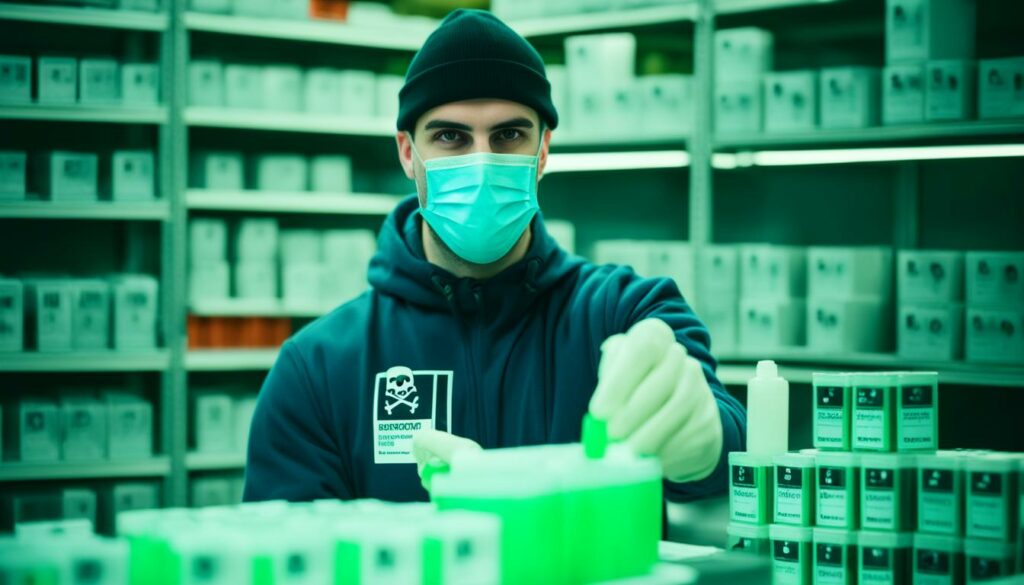
To summarize, printer ink and toner, while not highly toxic, should be handled with care to ensure safety. Using authentic, brand-name products and following manufacturer’s guidelines are important to reduce health concerns. Printer ink is generally safe for its intended uses, but it is always best to take precautionary measures to protect yourself and the environment.
| Printer Ink and Toner Safety at a Glance |
|---|
| Printer ink and toner are not highly toxic when used as intended. |
| Liquid printer ink is comparable in safety to ordinary dish soap. |
| Toner can be a respiratory irritant, but it is not classified as a toxic substance. |
| Consuming, inhaling, or getting printer ink in your eyes can cause illness or irritation. |
| Exposure to printer ink and toner under normal circumstances does not result in life-threatening conditions. |
| Using authentic, brand-name products and following safety guidelines is crucial. |
How to Avoid Ink Accidents
To minimize the chance of experiencing ink accidents, it is important to take certain precautions to ensure your safety. By following these safety tips, you can reduce the risk of mishaps and enjoy hassle-free printing experiences.
1. Ensure Good Ventilation
When using your printer, make sure the area is well-ventilated. Good airflow can help prevent the buildup of potentially harmful fumes or dust particles that may be released during the printing process. This can protect both your health and the performance of your printer.
2. Properly Store and Dispose of Cartridges
When it comes to ink and toner cartridges, proper storage and disposal are crucial. Keep cartridges in sealed containers or their original packaging to prevent accidental leaks or spills. Additionally, when disposing of cartridges, opt for environmentally friendly methods. Many office supply stores and manufacturers offer cartridge recycling programs.
3. Wear Protective Gloves
When handling ink and toner cartridges, it is advisable to wear protective gloves. This can help prevent ink from getting on your skin and minimize the chance of accidental contact. Latex or nitrile gloves are suitable options for this purpose.
4. Practice Proper Cleaning Techniques
Ink stains can be a common occurrence, but proper cleaning techniques can help remove them effectively. If you accidentally get ink on your skin, wash it off immediately with soap and water. For stubborn stains, use rubbing alcohol or vinegar as solvents. Nail polish remover can also be effective in removing ink stains from fingernails.
Remember to follow the instructions provided by the manufacturer for cleaning ink stains from different surfaces or materials.
Tip: Always test any cleaning solution on a small, inconspicuous area before using it on a larger stain or surface.
5. Follow Printer Safety Guidelines
Lastly, it is essential to familiarize yourself with the safety guidelines provided by your printer’s manufacturer. These guidelines will outline specific precautions and recommendations for safe use. By adhering to these guidelines, you can further minimize the risk of ink accidents.
By following these safety tips, you can avoid ink accidents and ensure the safe use of printer ink and toner.
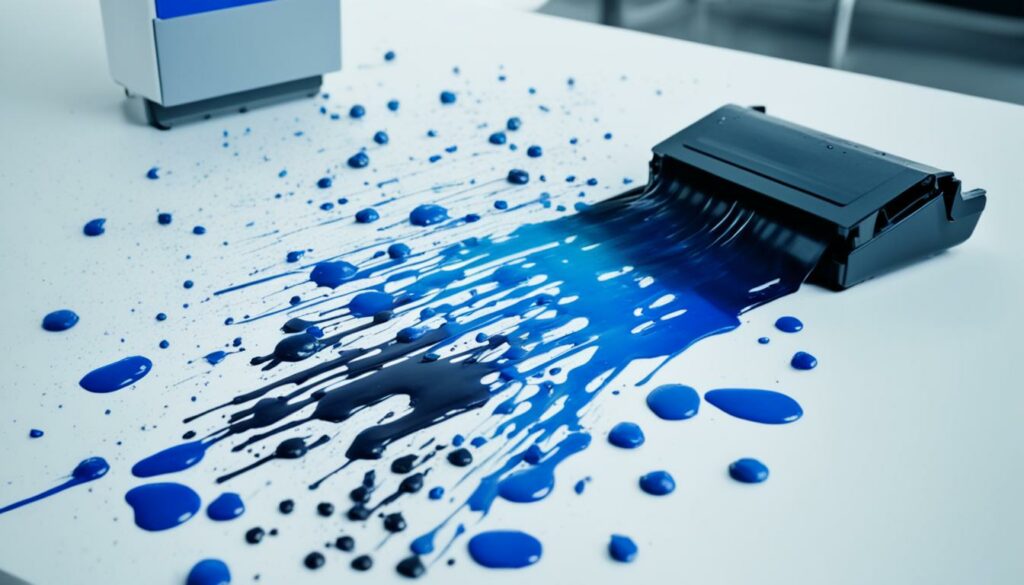
Comparison of Safety Tips to Avoid Ink Accidents
| Safety Tips | Description |
|---|---|
| Ensure Good Ventilation | Proper airflow in the printing area to prevent the buildup of toxic fumes or dust particles. |
| Properly Store and Dispose of Cartridges | Sealed storage and environmentally friendly disposal methods for cartridges to prevent leaks or spills. |
| Wear Protective Gloves | Use latex or nitrile gloves when handling ink and toner cartridges to avoid contact with the skin. |
| Practice Proper Cleaning Techniques | Effective methods for removing ink stains, such as using solvents like rubbing alcohol or vinegar. |
| Follow Printer Safety Guidelines | Adhering to the manufacturer’s safety guidelines for safe use of the printer and its components. |
Conclusion
In conclusion, it is important to handle printer ink and toner with care to ensure safety while using these products. While printer ink and toner are not highly toxic, taking precautions and following safety tips can minimize the risk of accidents or exposure.
Knowing the ingredients of printer ink, such as water, ethylene glycol, and alcohol, can help users understand the potential risks and handle the products accordingly. Additionally, being aware of cleaning techniques for ink stains and following recommended safety precautions can further reduce the likelihood of accidents.
When working with printer ink and toner, it is recommended to use authentic, brand-name products and follow the manufacturer’s guidelines. This helps to ensure that the ink and toner you are using meet industry standards and are less likely to pose health risks. Lastly, proper disposal methods should be practiced to protect the environment.
While printer ink is generally safe for its intended uses, being cautious and informed about safety tips is always advisable. By following these guidelines and using printer ink and toner responsibly, you can enjoy the convenience of printing without compromising your well-being.
Source Links
- https://cash4toners.com/is-printer-ink-toxic/
- https://www.inkjetwholesale.com.au/blog/printer-education/is-printer-ink-toxic-how-can-you-protect-your-skin-from-harm/
- https://www.selltoner.com/blog/is-printer-ink-toxic/

Morgan Azhari, the owner of PrinterUpdate.net, is a dedicated expert in the field of printers, leveraging a wealth of experience and education to create a platform that passionately shares insights and solutions.
With a goal to enhance the printer user experience, my vision for the website is to provide valuable content, making a positive impact on individuals navigating the complexities of printers.
